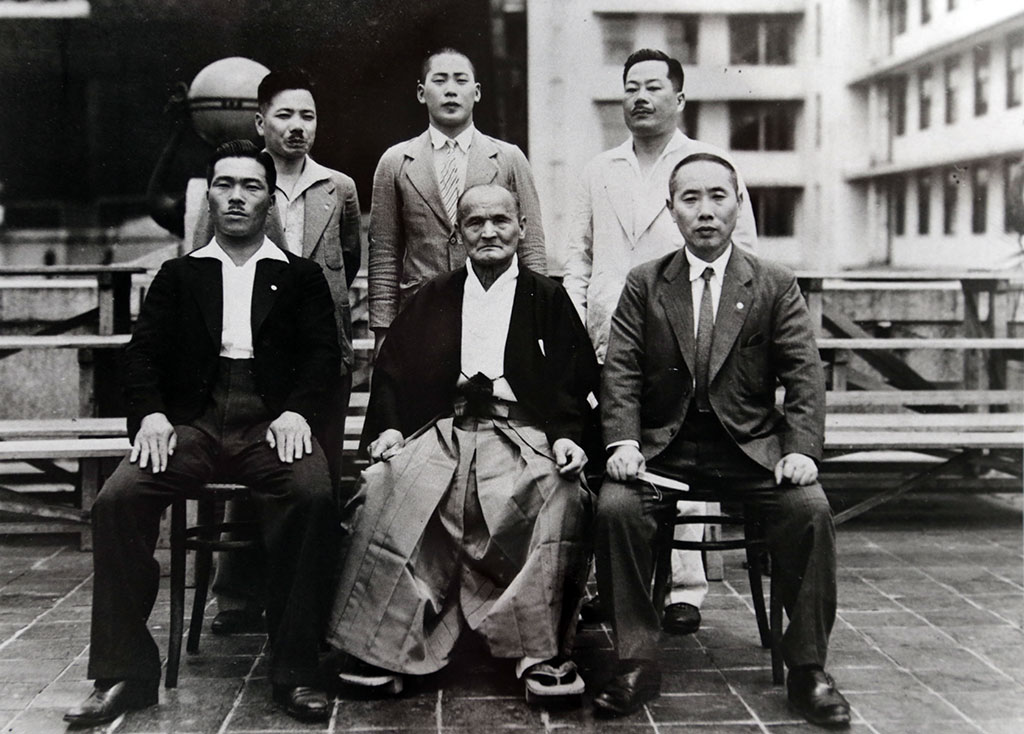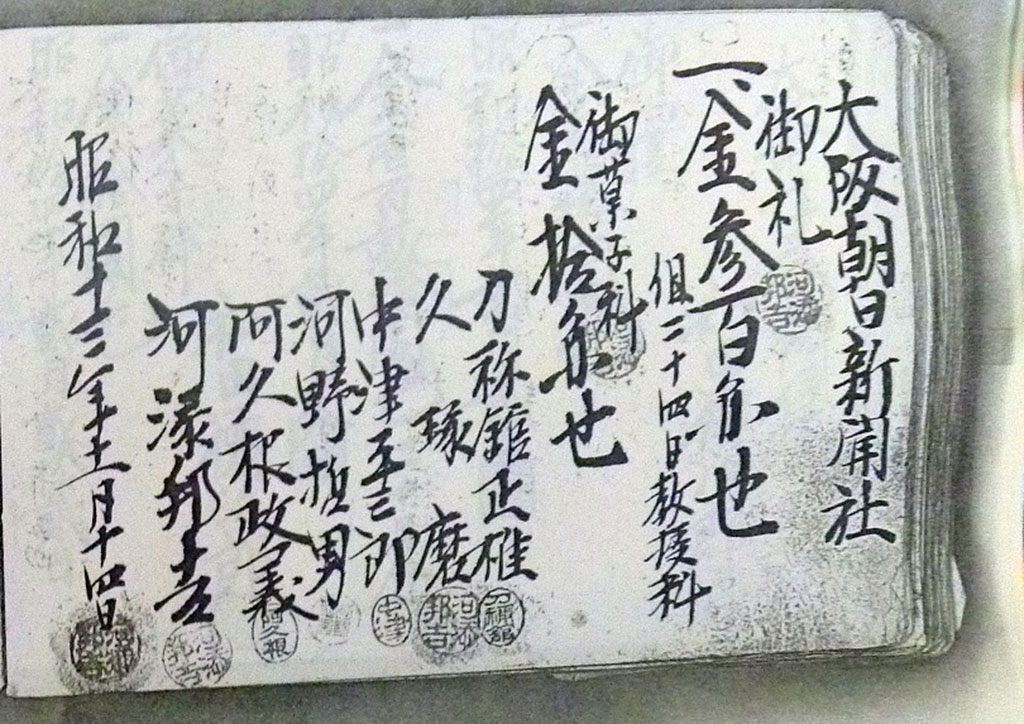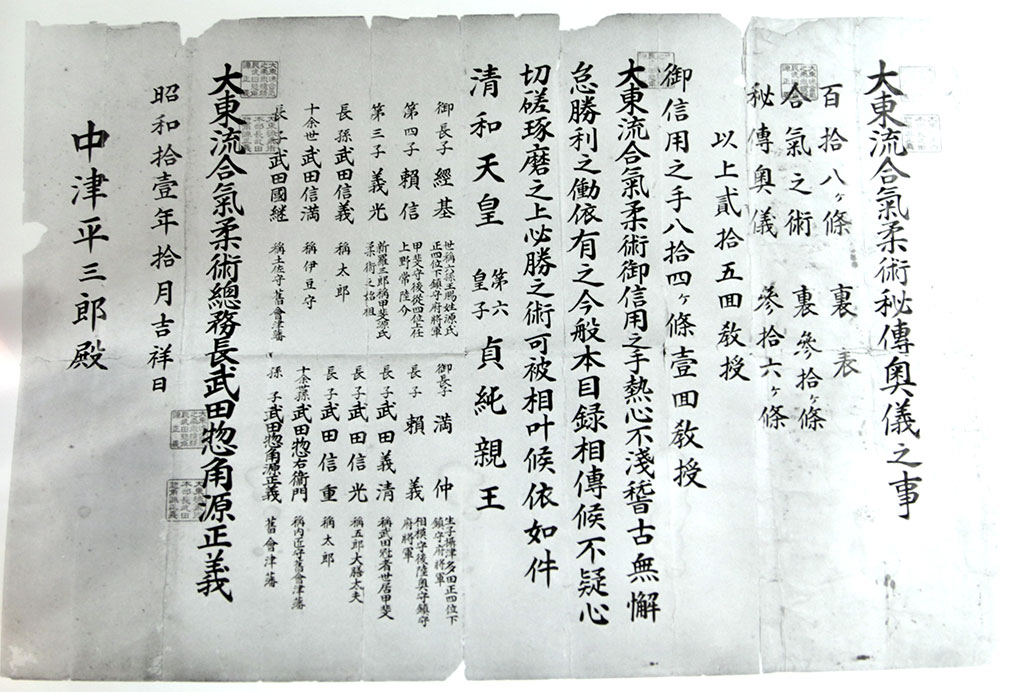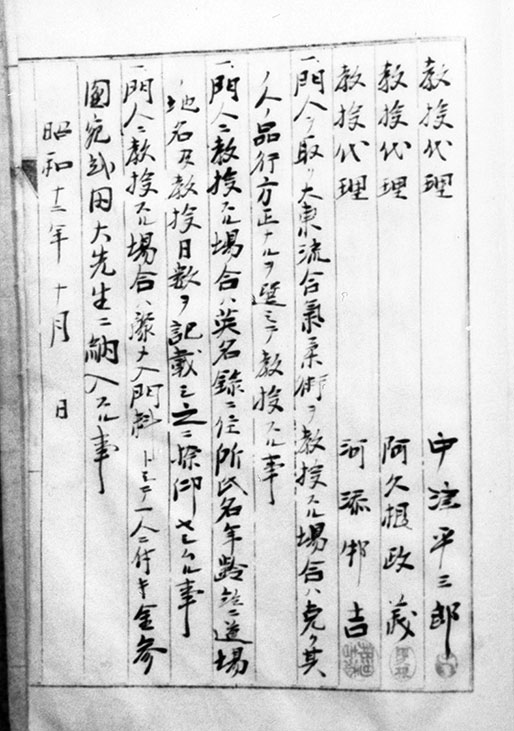Biography of Nakatsu Heizaburo [Daito-ryu of Shikoku #1]

Nakatsu Heizaburo
Nakatsu Heizaburo was born on June 1, 1894 in Ikeda in the Tokushima Prefecture of Shikoku. He served as a police officer at the Sonezaki Police Station in Osaka during the Taisho Era. A renshi 5th dan in judo from the Kodokan, he achieved a solid record as a competitor and his strong man reputation led to his recruitment in the early 1930’s into the Asahi Shinbun security team by Ishii Mitsujiro, a former minister in the Japanese government and a founder of the Liberal Democratic Party. Ishi put the group together in order to strengthen security in the Osaka branch of the journal following several attacks by right-wing extremists, and he placed it under the leadership of the Director of General Affairs Office of the newspaper, Hisa Takuma.

Ueshiba Morihei in front of the Osaka Asahi Newspaper. On his right is the study group’s leader, Hisa Takuma (1935).
In 1933, Ueshiba Morihei was invited to Osaka to teach the security team. Nakatsu, Hisa, and a handful of others therefore began to study the techniques of Daito-ryu aiki-jujutsu from him at the newspaper’s dojo, as well as in a number of other locations such as the Sonezaki Police Station. When Ueshiba was absent, some of his students from Tokyo would ensure the teaching at the newspaper, particularly Yonekawa Shigemi and Yukawa Tsutomu.

The Asahi Shinbun group around Takeda Sokaku. First row, left to right: Yoshimura Yoshiteru, Takeda Sokaku, Harada Bunsaburo; second row: Kawano Testuo, Takeda Tokimune, Nakatsu Heizaburo.
Instruction under Ueshiba Morihei’s direction ended in June 1936 with the arrival to Osaka of his own teacher, Takeda Sokaku. Takeda announced to the group that given the fact that he had not taught everything he knew to Ueshiba, it would be he who would lead the training of the Asahi students from that point on. Interestingly, even though Ueshiba Morihei was already operating the transition towards what he would later call “aikido”, the techniques that he taught at the journal were those of Daito-ryu aiki-jujutsu. Indeed, Sokaku himself must have thought that the students had been adequately trained by Morihei, since he decided to teach the higher level techniques when he took over rather than starting from scratch. Some evidence suggests that for a time, Ueshiba and Takeda actually both taught the Asahi group, though they did so in distinct locations.

Excerpt from Takeda Sokaku’s ledger showing that Tonedate Masao, Hisa Takuma, Nakasu Heizaburo, and Kono Tsuneo were present on November 14th 1938 and that a fee of 1300 yen was collected.
The financial arrangements around Morihei and Sokaku’s teaching at the journal are unclear, but a number of entries pertaining to that time and location can be found in Sokaku’s shareiroku.
Throughout this period, the students had taken the habit of making use of the cutting edge material available at the journal and to photograph themselves performing the techniques that they had learned in class. According to the legend circulating within Hisa’s organization, the Takumakai, those photo sessions took place secretly after classes, while the teacher was taken to the bath by Hisa or Nakatsu. More than 1,500 pictures were taken and carefully preserved in envelopes. A few years later, between 1942 and 1944, Hisa Takuma annotated some of these pictures and organized them in several volumes under the name of Soden.

Excerpt from volume 6 of the Soden, which shows Nakatsu Heizaburo applying the advanced techniques taught by Ueshiba Morihei on Kono Tsuneo.
Some explanations on how to perform the techniques were also added, most likely not directly by Hisa himself, but based on his oral instructions. Even though a total of 547 techniques are recorded in the Soden, hundreds of additional techniques are said to have been taught at the journal. The pictures reproduced herein come from the microfilm that Stanley Pranin received from Hisa, and unfortunately, the quality is substantially lesser than that of the original.
Even though Ueshiba Morihei awarded certificates to some of his students in Osaka, such as the Aioi-ryu okui no maki that he awarded in March 1937 to Morita Giichi, the chief of the Sonezaki police station, there is no evidence suggesting that he awarded any Daito-ryu titles to the Asahi Newspaper staff. Takeda, however, did issue a number of certificates once he took over. For instance, Nakatsu was awarded the hiden ogi no koto in October 1936.

Hiden ogi no koto certificate of Nakatsu Heizaburo dating from October 1936.
Then in December 1937, Takeda promoted Nakatsu and a number of fellow students to the title of kyoju dairi certificate, which allowed them to teach as representatives of Sokaku. The event is recorded in Sokaku’s eimeiroku and the text referring to monetary arrangements reads as follows: “When instructing students, an initial payment of three yen shall be made to Takeda Dai Sensei as an enrollment fee.”
Note that this is the same certificate that Takeda had awarded to Morihei Ueshiba after he had taught his art to him in Ayabe in 1922, under the same financial arrangement.

Excerpt from Takeda Sokaku’s eimeiroku showing that he promoted Nakatsu Heizaburo, Masayoshi Akune, and Kuniyoshi Kawazoe to kyoju dairi in October 1937.
According to Takeda Tokimune, the son of Takeda Sokaku, the kyoju dairi was only issued once the student had mastered the 118 shoden basic techniques (equivalent to today’s 5th dan), the 53 aiki no jutsu techniques (omote and ura), the 36 hiden ogi techniques (omote and ura), the Daito-ryu nito-ryu hiden techniques, and the 86 goshin you no te techniques. It therefore represents a very high standard of instruction and at the time he gave it to Ueshiba Morihei, this certificate was the highest title to be awarded by Takeda Sokaku. Later, in 1939, Takeda awarded the menkyo kaiden certificate to Hisa Takuma, hence making him the most highly ranked Daito-ryu practitioner ever and his successor as the technical head of his art.

Takeda Sokaku and Hisa Takuma posing with Hisa’s menkyo kaiden
It is a fairly well accepted fact that though he taught during classes and seminars, Takeda Sokaku tailored his teaching to each of his students. For instance, Hisa’s background was in sumo, and Sokaku Sensei, who was very fond of sumo himself, taught him techniques that were similar to those in sumo. Nakatsu being a very experienced judoka, his zanshin was different, and the techniques he learned from Sokaku were slightly different and adapted to him, especially in terms of a higher guard, firmly grounded with legs apart, which Nakatsu referred to as standing like a Nio statue. This highlights the fact that even in a relatively small study group like the that of the Asahi Newspaper, there were noticeable technical differences between each member, and those are still visible today in the respective lines that each student of Sokaku created. As a consequence, Shikoku’s Daito-ryu is indeed quite distinct from that of the Kansai area.

Front from left: Hisa Takuma,Takeda Sokaku, Harada Josaburo, Yoshimura Yoshiteru, unknown. Back from the left: unknown, unknown, Takeda Tokimune, unknown, Nakatsu Heizaburo, Kono Tsuneo.
When reading about Daito-ryu history, there are relatively few records about Nakatsu Heizaburo, especially in the English language, but he is sometimes mentioned by other prominent Daito-ryu instructors during the course of interviews, such as here with Mori Hakaru Sensei, the Director of the Takumakai.
“At that time, there was a person named Nakatsu Heizaburo who was training with Hisa Sensei, but according to Takeda Tokimune Sensei, his technique was the best among the people who were training at the Asahi. Moreover, it seems that he was technically superior to Hisa Sensei”
Interview with Mori Hakaru, Part 1 – Aiki News # 81

Excerpt from Volume 9 of the Soden with Nakatasu Heizaburo demonstrating the advanced techniques taught by Takeda Sokaku.
Those are high praises, especially coming from the son and successor of Takeda Sokaku as head of Daito-ryu. Tokimune was indeed present in Osaka at the time and was able to assess directly the level of competence of the Asahi group.
Moreover, Nakatsu Sensei is also featured quite prominently as a demonstrator in the Soden. Perhaps even more significantly, he is seen demonstrating both the most advanced techniques of Ueshiba Morihei in Volume 6, and many of those taught by Takeda Sokaku in Volumes 7 to 9, hence suggesting that he had mastered the higher level techniques of Daito-ryu, which could only have come from a sustained and close learning relationship with Takeda Sokaku.

Nakatsu Heizaburo surrounded by his students. Chiba Tsugutaka is in the second row on Naksatsu’s left.
Though Sokaku stopped teaching at the journal in 1939, Daito-ryu practice continued afterwards under the direction of Hisa. Unfortunately, Nakatsu suffered from a mild stroke in 1943 and he had to retire from the journal. He returned to his native Ikeda to set himself up as a chiropractor. Between patients, he also taught the Daito-ryu he learnt from Ueshiba and Takeda to a small group of students, including Chiba Tsugutaka, Makita Kan’ichi, and Onishi Masahito in the 4-tatami waiting room of his cabinet. Note that at that time, the practitioners of the Kansai area had not yet reconnected with Takeda Tokimune and therefore, they were not studying based on his standardization of the 118 hiden mokuroku techniques
Nakatsu was honored with the 6th dan in judo from the Kodokan in January 1960. He passed away in December the same year, at the age of 66.
About the author

Guillaume Erard
Guillaume Erard is an author and educator, permanent resident of Japan. He has been training for over ten years at the Aikikai Headquarters in Tokyo, where he received the 6th Dan from Aikido Doshu Moriteru Ueshiba. He studied with some of the world’s leading Aikido instructors, including several direct students of O Sensei, and has produced a number of well regarded video interviews with them. Guillaume now heads the Yokohama AikiDojo and he regularly travels back to Europe to give lectures and seminars. Guillaume also holds the title of 5th Dan in Daito-ryu aiki-jujutsu and serves as Deputy Secretary for International Affairs of the Shikoku Headquarters. He is passionate about science and education, and he holds a PhD in Molecular Biology. Guillaume’s work can be accessed through his website and on his YouTube channel.














